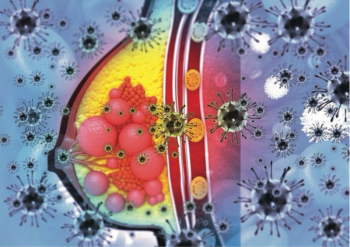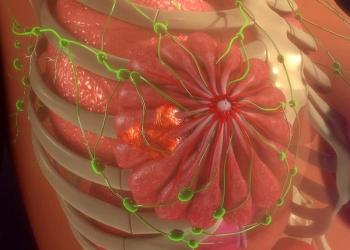
Oncology NEWS International
- Oncology NEWS International Vol 6 No 4
- Volume 6
- Issue 4
Mucin Markers May Play Role in Finding Breast Cancer Recurrences
At a symposium sponsored by Schering-Oncology/Biotech, 16 researchers involved in studies of the investigational antiestrogen agent toremifene (Fareston) discussed its potential role in the treatment of patients with advanced breast cancer and as adjuvant therapy, as well as other breast cancer issues. Previous articles in this series appeared in January 1997 , February 1997 , and March 1997
At a symposium sponsored by Schering-Oncology/Biotech, 16 researchersinvolved in studies of the investigational antiestrogen agent toremifene(Fareston) discussed its potential role in the treatment of patients withadvanced breast cancer and as adjuvant therapy, as well as other breastcancer issues. Previous articles in this series appeared in January 1997, February 1997 , and March 1997
PALM SPRINGS, Calif--Although most of the mucin markers used to detectbreast cancer recurrence were developed by different laboratories at differenttimes, all recognize the products of the MUC 1 gene, Roy Beveridge, MD,of Fairfax Oncology/Hematology Associates, Annandale, Va, said at the symposium.
CA 15-3 is not specific for breast cancer, he said. Half of patientswith prostate, ovarian, or pancreatic cancer, for example, have an elevatedCA 15-3. Roughly half of patients with stage IV breast cancer have an elevatedCA 15-3, and between 10% and 20% of stage II patients have elevations ofthis marker.
Although newer versions of CA 15-3 are being developed, its value iscurrently limited because of assay variability and the wide range of levelsconsidered normal. "Unless the level doubles, it doesn't mean verymuch," he said.
CA 27-29 (Truquant BR RIA) is similar to CA 15-3 but may be more specific.The intra-assay variability is perceived to be less with CA 27-29 thanwith CA 15-3 tests, he said, and many labs have switched to the FDA-approvedCA 27-29 marker.
CA 27-29 was evaluated in a prospective double-blind multicenter clinicaltrial of about 200 patients with stage II or III breast cancer who wereclinically free of disease at the time of enrollment.
Of the 26 patients who had recurred at four years, 15 had an elevatedCA 27-29, yielding a specificity of 98% and sensitivity of about 60%. Thelead time (from tumor diagnosis to elevated CA 27-29) in patients who haddistant metastasis was six to seven months. In patients who had local regionaldisease, it was two months, presumably because the volume of disease issignificantly less in these patients.
Of 29 patients with bone pain who had negative repeat bone scans, everyone also had a negative CA 27-29. Of the three bone pain patients who hadan elevated CA 27-29, all three had documented cancer recurrence. "Sothis mucin marker may have a particular value in bony disease," Dr.Beveridge said, since patients with elevated marker levels are good candidatesfor further testing.
The test probably has less value in patients with local regional disease,he said. However, in these patients, two consecutive elevations suggestcontinued disease growth, and, in that situation, "re-starting treatmentor changing to a different regimen might be reasonable."
Within the medical community, Dr. Beveridge said, "many peoplesay, well, you've identified metastatic breast cancer seven months beforeyou would have found it by physical exam, but so what? You have no datato show that early treatment of metastatic disease improves survival."He answers that the information may be particularly useful in certain subpopulationssuch as patients with bone pain and younger patients who might want aggressivetherapy when they are first diagnosed with metastatic disease.
When a member of the audience asked if an elevated CA 27-29 is an indicationto treat the patient empirically, Dr. Beveridge said that in general itis not, "but there is a trial that is being organized right now toanswer that question." When patients in the study group have an elevatedCA 27-29, they will be given the choice of receiving empirical treatmentor continued monitoring.
Articles in this issue
over 28 years ago
Myoepithelial Cells May Be Key to Suppression of DCIS Growthover 28 years ago
Some Breast Cancer Patients May Not Need Node Dissectionover 28 years ago
Irinotecan Easier to Give as Physicians Gain Experienceover 28 years ago
Guidelines Highlight Staging Technologies For Pancreatic Cancerover 28 years ago
Lumpectomy Alone Appears to Be Safe In DCIS Patientsover 28 years ago
Multimodality Treatment Appears Safe for Pregnant Womenover 28 years ago
McGivney Outlines 'Ambitious Agenda' For NCCN in 7 Areasover 28 years ago
Capecitabine Studied In Advanced Colon Cancerover 28 years ago
When Antiandrogens Work, Patients Have Normal Quality of LifeNewsletter
Stay up to date on recent advances in the multidisciplinary approach to cancer.

















































































